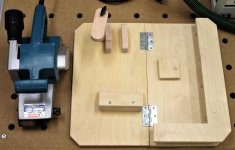Dick Mahany
Member
- Joined
- Jan 8, 2016
- Messages
- 555
My 20 year old Makita 9924DB belt sander has often sat unused as of the last few years. Fortunately I came across this excellent bench mount design published in 2011 by John Heisz in ibuildit.ca. It was quick and simple to build and makes using a belt sander great for bench projects. This sander is still produced today although the major downside of the design is the rectangular port for the Makita dust bag. I found a vac hose end that was able to be stretched around it and now I just need to make an adapter to fit it to my CT hoses.
[attachimg=1]
[attachimg=2]
[attachimg=3]
[attachimg=1]
[attachimg=2]
[attachimg=3]



